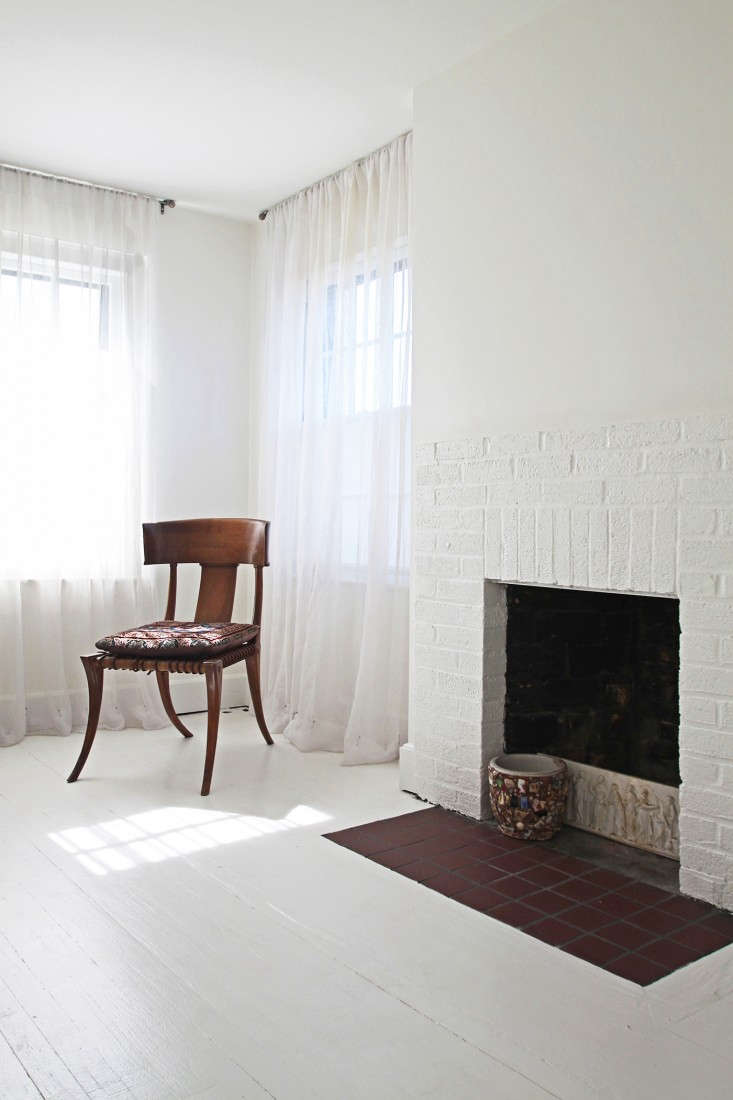
Since Alexa discovered the small apartment of designer Paige Geffen (see The LA Rental, Upgraded: Designer Paige Geffen’s 500-Square-Foot Challenge), I’ve been poring over the photos. Geffen’s rental shows us how to make the most of a small space: with a sharp eye and careful placement of furniture, rugs, and lighting—placing two armchairs just so to create an entry, or pairing an oversized hutch with a low-slung bed to play with scale—a unremarkable rental became effortless and functional. I studied the post for design tricks, and found myself trying to replicate Geffen’s smart, simple choices in my own place.
I decided I had to go back to the source. Geffen moved out of her Echo Park flat since we ran the original story—she recently relocated to Topanga Canyon “to connect with/spend more time in nature,” she says, where’s she’s living, for now, in a furnished rental. “I did end up selling nearly all of my furniture in order to clear space in my life and start anew,” she says. “I definitely encourage people to invest in pieces they will be able to love and keep for a long time. However, letting go and starting fresh can be a very freeing experience. Renting is about adapting to change and creating space that suits where you are in life at the moment.” We asked Paige what transformative but unexpectedly simple tips she uses for arranging her small spaces, then and now. Here’s what she had to say.
Photography by Bethany Nauert and Lauren Moore, courtesy of Paige Geffen and from Designer Paige Geffen’s 500-Square-Foot Challenge, except where noted.
1. Resist the urge to go miniature.

“Don’t be afraid to place regular-sized furniture in small spaces. When you put tiny furniture in a small space, the room will actually feel smaller. I encourage you to play with scale. You can still use the negative space wisely to help the eye move throughout the room.”
2. Lay out “rooms.”

“Use rugs to designate space. This is especially helpful in studios or open floor plans. Use a large rug for your living space, and a runner to create an entry. Textiles add richness to the space while giving you creative freedom.”
3. Check for visual balance.
“Rely on creative styling to offset any odd configurations. In small spaces, we often have to sacrifice ideal spacial planning in order to fit in what we need. Strategically place a plant next to your sofa that is slightly off-centered in the room, so that the eye won’t notice, or place art lower than you normally would to add visual weight where needed.” (Case in point: in her Echo Park apartment, Geffen couldn’t find a way to center the sofa between the windows, so she added an oversized potted plant to distract the eye.)
4. Where there’s a window, add a mirror.

“Mirrors create the illusion of bigger space. If you can, place a mirror across from a window. It will reflect the outdoors/what’s outside and make your space feel larger.”
5. Close a door.
“Invest in multipurpose pieces. Perhaps you can find a coffee table or bench with hidden storage inside, or a credenza with doors that will hide items you don’t want seen, while still being able to place your favorite decorative items and books on top to display.”
6. Add height.

“Build up. Use the wall space, as you may not have as much floor space to work with. Shelving can hold books, records, ceramics, etc. Get creative with it.”
7. Fake taller windows.

“If you have drapery, hang the curtains from the ceiling, rather than from the top of the window. This will create the illusion of higher ceilings. You can also use drapery to create doorways and soften the space.”
8. Make blank space intentional.
“Leave some negative space on the walls. If you have a lot of art to display, I recommend spacing the pieces out throughout the room. I don’t follow ‘rules’ in design, but I tend to dislike gallery walls in small spaces because this can make rooms feel tight and cluttered. Place a few pieces together on one wall, and then leave the rest of the wall naked. This will allow the eye to glide through the space.”
9. Take your time.

“Stay true to yourself. Don’t allow lack of space to make you feel like you have to sacrifice personal style. You want your space to feel like you, as well as to serve you. Sometimes, you need to leave all of the rules at the door. Have fun with designing, and take your time in order to know how you want each area to function in order to make every square foot count.”
N.B.: Follow Geffen on Instagram @paigegeffen.
As it turns out, there are many ways of making the most of a small space, and many opinions on what’s best. Case in point: the number one tip in Expert Advice: 11 Tips for Making a Room Look Bigger? Seek out petite, clean-lined furniture—not heavy or oversized pieces. For a wide look at small-space tips to try in your own space, see more of our posts on the matter:






Have a Question or Comment About This Post?